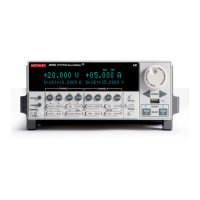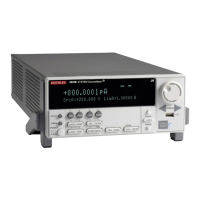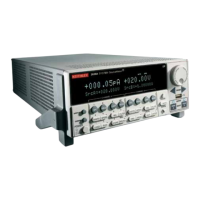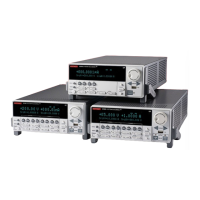3: Functions and features Series 2600B System SourceMeter® Instrument
3-44 2600BS-901-01 Rev. B / May 2013
Timer delays
Timers can be configured to perform the same delay each time or configured with a delay list that
allows the timer to sequence through an array of delay values. All delay values are specified in
seconds.
A delay is the period of time after the timer is triggered and before the timer generates a trigger event.
The programming example below illustrates how to configure timer 3 for a 10-second delay:
trigger.timer[3].delay = 10
You can configure a custom delay list to allow the timer to use a different interval each time it
performs a delay. Each time the timer generates a trigger event, it uses the next delay in the list. The
timer repeats the delay list after all of the elements in the delay list have been used. The
programming example below illustrates how to configure timer 3 for delays of 2, 10, 15, and 7
seconds:
-- Configure timer 3 to complete delays of 2 seconds, 10 seconds,
-- 15 seconds, and 7 seconds.
trigger.timer[3].delaylist = {2, 10, 15, 7}
Assigning a value to the delay attribute is the same as configuring it with a one-element delay list.
Pass-through mode
When enabled, the timer generates a trigger event immediately when it is triggered. The timer
generates additional trigger events each time a delay expires. If the pass-through attribute is
disabled, the timer does not generate a trigger event until after the first delay elapses. The
programming example below illustrates how to configure timer 3 by enabling pass-through mode:
trigger.timer[3].passthrough = true
Triggering a timer
A timer can be configured to start a delay when a trigger object generates a trigger event. Timers
cannot be started with a command. A trigger event from a trigger object must be used to initiate a
delay.
Assigning the stimulus attribute
Assign an event ID to the trigger.timer[N].stimulus attribute to configure the timer to start a
delay when a specific trigger event occurs. The programming example below illustrates how to
configure a source-delay-measure (SDM) cycle.
-- Configure the timer to begin when source action completes.
trigger.timer[1].stimulus = smua.trigger.SOURCE_COMPLETE_EVENT_ID
-- SMUA delay before a measurement begins.
smua.trigger.measure.stimulus = trigger.timer[1].EVENT_ID

